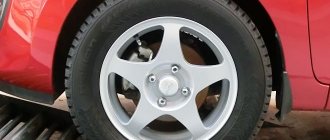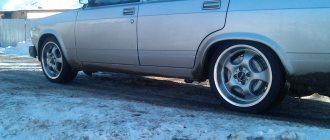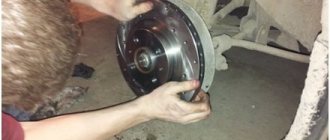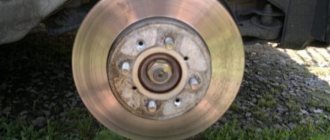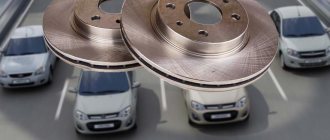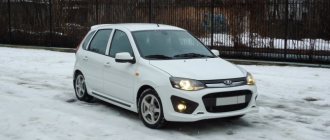The most vulnerable element of the braking system is the discs. If you do not carry out a technical inspection of the car on time and do not change parts in a timely manner, this can lead to fatal consequences in certain driving situations.
Unfortunately, it is impossible to name the minimum thickness of brake discs, since it depends on the car model and brand. Each manufacturer sets its own wear values, which are determined depending on the characteristics of a particular vehicle. Thus, there are no universal evaluation criteria. The wear of the part directly depends on the driving style of the motorist, more precisely on his braking style, and the condition of the roads: if you drive on rocky areas all the time, the brake discs wear out three times faster. Also, premature wear is strongly influenced by the insufficiently large area between the pad and the disc. To prevent accidents, car manufacturers indicate the nominal and minimum thickness of the part in the form of two marks on the discs themselves. It is worth noting that factories slightly increase the latest figures, indicating the thickness “with a margin”.
MINIMUM ALLOWABLE THICKNESS OF FRONT BRAKE DISCS
When you hold the brake disc in your hands, you can see two numbers. The first means the initial thickness of the part, and the second means the minimum allowable thickness. If there are no marks on your disk, then it is “fake”, simply a fake. Any mechanic at a service station will be able to determine at a glance the condition of your brake disc and tell whether it can be used or should be replaced. How can we determine wear and tear ourselves? The first step is to measure the thickness of the product. It is measured with an ordinary caliper. Please take into account the fact that the thickness may differ in different areas of the part due to alignment errors. There are several signs of a worn brake disc: braking is accompanied by shaking of the steering column and vibrations throughout the car. Most often, such “symptoms” are observed during emergency braking. In this case, it is recommended to carry out a complete diagnosis of the vehicle, because such problems can arise not only as a result of brake failure; When braking, extraneous noises are heard, mainly “squeaking”. However, this may be a sign of wear on the brake pads, not the discs. Do not hesitate to replace the part, because if you continue to use it, the manufacturer will refuse warranty service.
RESIDUAL THICKNESS OF BRAKE DISCS - POSSIBLE RISKS
Using worn brake discs can have many negative consequences. For example, when a driver brakes, a frictional force occurs between the pad and the disc. Once heated to the peak temperature, the part may become deformed. This will result in damage to the entire braking system. If the thickness of the disk is already less than permissible, it loses its strength, which in turn threatens to split the part. This phenomenon can only be observed during braking. Failure to stop in a certain situation has catastrophic consequences. It would be good if there were no casualties. Timely technical inspection of the car is the key not only to its smooth operation, but also to your safety. Once a month, or even more often, check the main elements of the machine for serviceability.
Source www.drive2.ru
The minimum and permissible thickness of the brake disc is regulated by the degree of wear of the unit. Each manufacturer sets its own value, which varies between car models.
The braking system is responsible for the immediate safety of the driver and passengers. Increased demands are placed on her. The permissible thickness should not exceed the permissible values, this must be vigilantly monitored.
Brake disc features
Automobile brake discs are made of high-quality refractory cast iron with the addition of phosphorus, sulfur, manganese, and silicon. In addition to high hardness, such a material of the assembly better removes the high temperature that regularly occurs during the braking process.
When you press the pedal, the pads compress the disc on both sides. Enormous forces of compression, friction, and heat transfer to the entire brake system arise: fluid, pipelines, wheels.
Modern high technologies have allowed manufacturers to produce automobile brake discs from ceramics, as well as from carbon fiber, in other words, from carbon fiber. They are lighter, dissipate heat better, are more reliable, efficient, and more durable.
However, nothing lasts forever. The time comes when even such modern components also wear out and must be replaced with new ones.
Frequent overheating and subsequent cooling cause the outer edges of the brake discs to regularly rise and fall. The planes ground with pads warp and become deformed.
This reduces braking efficiency. There is a runout of the pads along the plane of the discs. This situation is felt in the steering wheel, which begins to wobble to the sides when braking. There are shocks in the brake pedal.
What is this detail?
The brake pad is a steel plate with a lining made of materials that can withstand high friction. She constantly works in unfavorable conditions. In addition to the aforementioned friction and subsequent heating, it is affected by water (which leads to a sharp temperature change) and other factors, for example, road reagents. Over time, cracks appear on the surface of the linings, their thickness decreases, and the car begins to brake worse.
[custom_ads_shortcode1]
Factors affecting wear
Brake discs are particularly vulnerable parts of a car. The following factors contribute to these processes:
- constant friction processes;
- extreme temperature fluctuations;
- heavy dust in the braking zone;
- rugged terrain.
Late maintenance or its complete absence often leads to fatal consequences. In specific driving situations, it is too late to recognize that the brake discs have worn out beyond the permissible limit. Because of this, tragedies often occur on highways around the world.
Due to the heavy load conditions of the brake discs, they are first covered with a network of small cracks. Over time, minor depressions expand. During emergency braking at high speed on a busy highway, the disc shatters into fragments. The car becomes uncontrollable.
Car owners should make it a rule to visually inspect brake components always before leaving the garage, and also have their car mechanics perform regular maintenance after every 10 thousand kilometers.
This is usually done during periodic changes of engine oil, air filter and all technical materials: antifreeze, antifreeze, brake fluid, distilled water.
Minimum brake disc thickness
There are no universal criteria for measuring the minimum thickness of brake discs. The thickness of the brake disc depends entirely on the make of the vehicle, its model, and the car manufacturer.
Each company in the automotive industry sets its own individual wear characteristics. This largely depends on the dynamics of the car’s engine, its weight, the characteristics of the braking system, and the materials used.
Approximate average thickness parameters of automobile brake discs are shown in the table below:
The load wear of the brake disc depends entirely on external factors:
- The driver's driving mode when operating the vehicle.
- Frequency and style of braking.
- The condition of the road surface or its complete absence.
- Uneven or complete wear of the brake pads.
Constant use of the vehicle on stone roads or cobblestone roads will certainly lead to accelerated wear of the brake discs.
Long-term movement without braking on a high-quality highway surface, on the contrary, will preserve them for a long time from abrasion and destruction. Premature wear of discs can be accelerated by insufficient area between the disc and pad or misalignment of these components.
Additional questions and answers
What is the service life of brake pads and brake discs?
There are many factors that influence the average lifespan of your brake components. These include pad type, rotor type, your personal driving style and maintenance. According to most brake pad companies, as well as qualified mechanics, brake pads can last between 30,000 and 120,000 kilometers . At the same time, the front ones wear out about 3 times faster than the rear ones. On average, it is recommended to change pads on domestic cars approximately every 10,000 km, and on foreign cars - every 20,000 km. Actual service life can vary greatly, the main thing is to prosodicly check them and their thickness.
Left - new pads, right - old
The service life of brake discs is quite long - 3-4 times longer than that of pads. But again, it all depends on many other factors, such as how you maintain your braking system and how you drive your car. On average, this is more than 100,000 km. Here you also need to rely on the thickness of the rotors when taking measurements.
How much do new brake discs cost?
The average cost of new brake discs varies from 3,000 to 5,000 rubles each. Some rotors with the best characteristics can cost from 7000+ rubles each. Additionally, prices vary greatly depending on the type, brand, and quality.
New brake discs
When it comes to replacing brake rotors, some people often wonder whether they should buy new or remanufactured parts. Each of these types has its own advantages and disadvantages. For example, aftermarket parts tend to be cheaper and available in a wide range of options, while new brake rotors are easier to select and offer greater quality assurance.
Can I drive with worn rims?
Brake rotors play an important role in allowing your car to stop while it is in motion. If the rotors are not working properly, you may not be able to stop the machine properly in an emergency. This can lead to many dangers if you need to stop to avoid pedestrians, bicycles, car accidents or other traffic situations. So when you find that your brakes aren't performing as well as they should, you need to take your car to a mechanic as soon as possible to have the thickness of your rotors checked.
3.6/5 — (24 votes)
Permissible brake disc thickness
When operating a vehicle, to be completely confident in the effectiveness of the braking system, it is necessary to regularly service and check the degree of wear of the brake system discs and pads.
To do this, measurements are taken using a caliper. The permissible thickness of the brake disc is indicated by the manufacturer at its end, which does not wear out during operation.
The marking is applied to discs manufactured in compliance with international standards. In this case, the impact application method is used.
Car owners only need to know two parameters: the initial thickness of the disc and the minimum size at which the manufacturer is not responsible for trouble-free operation of the product. A brake disc worn down to minimum values must be replaced.
Video on the topic
1 Mark with paint the position of the wheels relative to the hub. This will allow the balanced wheel to return to its original position. Loosen the wheel bolts with the vehicle on the ground. Raise the front of the car, place it on stands and remove the wheels.
The thickness of the brake disc should be measured at its thinnest point.
2 Measure the thickness of the disc. Service stations use a special gauge or micrometer for this, since a shoulder is formed during the wear of the disk. The thickness of the disc can be measured using a regular caliper. To do this, you need to place a lining of a certain thickness (for example, two coins) on each side of the disk. Then the thickness of two coins must be subtracted from the value obtained as a result of the measurement. Attention: measurements must be taken at several points.
3 The dimensions of the brake disc are given in the Specifications. 4 If the resulting thickness is less than the minimum specified value, the brake disc must be replaced, refer to the appropriate section. 5 If the brake discs have been machined to their minimum thickness, you can reinstall the brake pad set. 6 If there are cracks or burrs, the brake discs must be replaced. 7 Reinstall the wheels so that the markings made during removal match. Pre-lubricate the centering belt of the wheel disk on the hub with a thin layer of bearing grease. Do not lubricate the wheel mounting bolts. Replace rusty bolts. Tighten the bolts. Lower the car onto the wheels and tighten the bolts crosswise to a torque of 100 N•m.
How to determine the erase thickness
Driving practice shows that at some point the car itself signals minimal wear on the brake discs. While driving on the highway, the car begins to behave inappropriately.
It is necessary to immediately measure the thickness of the brake components and take effective measures to ensure safety at home in the garage or in a certified car service center.
Symptoms of complete wear of brake discs:
- pressing the pedal causes the brakes to lock;
- at the moment of braking there is a strong grinding noise from under the wheels;
- at the moment of braking, vibration, jerking is felt, and characteristic clicks are heard;
- Cracks, chips, and scuffs appear on the surface of the discs.
You can measure the wear of the discs with a caliper, carry out initial diagnostics and visual inspection, you can do it yourself at home or at a service station.
The technical specifications table and the owner's manual for a specific vehicle shows the level of acceptable wear for a given model. Some errors in the planes of the disks can be eliminated by turning them.
If warping of the disk, cracks, or wear exceeding the table value is detected, such disks must be replaced without further hesitation. The safety of people is more important than any money.
Brake discs are replaced in pairs - either two front or two rear. In order to ensure one hundred percent confidence in the reliability of the brakes, it is best to change all four brake discs at once.
Conclusion
Every motorist must remember: good brakes are the key to safe driving for him and his passengers. Therefore, it is necessary to check the condition of the brake discs as often as possible to prevent excessive wear.
If chips, nicks, cracks, or minimal wear are detected, replace the discs yourself or use the services of professional technicians at a service station.
Source avtohomenew.ru
During the operation of the car, many car enthusiasts do not ask themselves what the minimum thickness of the brake disc should be for effective braking. But in vain, because this is an important value on which the safety of the car owner and his passengers depends. Therefore, the question of how to determine the wear of brake discs should be relevant for all drivers.
To clarify this issue, it is worth touching on the design of disks, what causes their wear, how to check it, what are the signs and what factors influence it.
Other reasons for replacing pads
In addition to situations with critical wear, it is necessary to change brake pads in the following cases:
- the thickness of the friction material is more than 5 mm, but the lining itself has begun to peel off from the steel base;
- cracks and chips appeared on the surface, the material began to crumble;
- stains of oil or brake fluid that reduce friction properties were found on the parts;
- when the brake drum or disc is replaced.
Another reason for replacement is due to the abundance of low-quality fakes on the automotive spare parts market . New pads purchased from an unreliable retail outlet begin to squeak or squeak terribly after 1-2 thousand km, although the working part is still far from completely worn out. The culprit is the material of the part, whose hardness is comparable to metal, causing the surface to “slick” and create a creaking sound. If the elements made from unknown materials are not replaced, then the production on the brake discs will increase sharply.
Many modern cars are equipped with special sensors that detect a decrease in the thickness of the friction layer and send a signal to the driver when it reaches a critical level. This is also a reason to remove parts with worn linings and install new ones.
True, the sensors often become clogged with dirt and lose their functionality, so it wouldn’t hurt for the car owner to check the condition of the brakes himself.
Design features
The bulk of the front and rear discs are made of cast iron. Its popularity was facilitated by its low cost and good friction properties. But the trouble is that during the braking process this material heats up. This can lead to warping, changing the shape of the working surface and ultimately uneven erasing. To minimize these phenomena, manufacturers began producing front and rear discs with internal ventilation. They also began to cut grooves on their surface and perforate this product. This made it possible to significantly reduce overheating and increase their operating time.
Effective adhesion between the pads and the disc begins only after they are ground in. At this time, you should not press the brake sharply, but stop smoothly. This usually happens with a mileage of no more than 1000 km. You can check the effectiveness of lapping on a special stand.
Factors affecting wear
Each manufacturer itself prescribes the permissible wear rate for the wheels of the car brand it produces. These parameters are calculated based on engine power, machine weight, and other things. But it is difficult to take into account the maximum mileage after which it will be necessary to change the brake discs. After all, this is influenced by factors that cannot be taken into account:
- Driving style. If there is extreme driving, in which acceleration is replaced by sharp braking, then the wear life can be significantly reduced.
- Conditions in which the vehicle is operated. If you constantly drive through puddles in slushy weather in winter, then moisture falling on a heated disc can cause its deformation and, as a rule, uneven wear.
- Mechanical factors. The material used to make this brake element plays a role here, as does the quality of the pads used. Typically, discs are made of cast iron, but over time they began to be made from other materials: steel, ceramics, carbon. This greatly increased their service life.
- Using poor quality pads can also cause uneven wear. As a result, you will have to change this element of the brakes.
Determination of erase thickness
To find out what the permissible maximum thickness of a disk is, you should pay attention to its end or look at the car’s manual. There are two values there - the initial and minimum thickness of these elements of the brake system. These numbers vary depending on the manufacturer of both the machine and the parts themselves.
If the disc wears down to a point where the maximum thickness does not allow effective braking, you should immediately change them. You can measure the thickness at a service station using a micrometer.
Or, by independently determining this with a caliper, in this case we measure the thickness of the front discs by clamping them with the front part of the tool.
They need to be changed when a check shows maximum wear or if the discs have different thicknesses. These values must be checked at different points of a given brake element. This is due to the fact that its abrasion occurs unevenly.
The drum-type rear disc is checked not by thickness, but by the internal distance (diameter) from one side to the other, also at several points.
Uneven wear, which causes runout, can be checked with a special device that detects fluctuations in hundredths of its values.
Identified errors: uneven wear or different thicknesses can be corrected by turning the brake discs. But a warped or cracked element definitely needs to be replaced.
Diameter
The brake power depends on the diameter of the rotor - the larger the diameter, the larger the lever, the stronger the braking.
There are several standard brake disc diameters (140mm, 160mm, 180mm and 203mm) and a few less common ones (170mm, 185mm, 200mm and 220mm). Country bikes are most often equipped with 160mm discs, sometimes 180mm are used for the front brake, and 140mm for the rear brake. In downhill and enduro you need to brake more; 180mm and 203mm discs are used. Typically, the size is indicated on the disk itself. If there is no inscription or it is not readable, you can measure the diameter with a ruler.
If you want to install a larger diameter wheel, you will need a spacer adapter. It will move the caliper away from the mounting points on the frame or fork the distance needed to accommodate the disc.
Such adapters are commercially available - each manufacturer has their own; they may differ for the front (letter F in the name) and rear (R) brakes - you need to check the compatibility and type of mount (PM or IS). Read about caliper mounting standards here and here.
Accordingly, in order to install a disk of a smaller diameter, the adapter (if any) must be removed. There are restrictions on the minimum and maximum size of the disc that can be installed - this depends on the design of the specific frame and fork. There are no adapters that would allow the installation of a smaller diameter disk. That is, if you have a disk with a diameter of 160mm installed without an adapter, you will not be able to install a 140mm one.
To avoid making a mistake when choosing a brake disc, check:
- compliance of the bushing with the fastening standard;
- diameter matching;
- when purchasing a larger diameter disk, do not forget to purchase a suitable adapter;
- Do you want to install a disk with a smaller diameter? Remove the adapter or (if you don’t have one) abandon this idea
And one more thing: brake discs and brakes from different manufacturers are compatible (take into account the size, it must match).
A short video about rotor wear:
Sprinter W901-W905. Brake system. Club of fans of minibuses and minivans
- Unanswered topics
- Active topics
- SearchMobile version


